|
Thursday 9th May 2013
The day started with a 6:00am wakeup call, and after breakfast
we were on the bus at 8:00am. The programme had been brought
forward by an hour to try and avoid the chaos from the planned
strikes and traffic expected in the city today. We headed south
to Valencia following the coast and the mountains on our right. It was about a four hour journey with a couple of
breaks on the way. There were also so protest marches in
Valencia and so our tour of the city had to be rescheduled. We
walked around the medieval quarter and saw numerous churches,
all following of which were closed. We rejoined the bus at the last
remaining city gate of the twelve which was built in 1392. We
were then driven down to the port area where a lot of money had
been spent by the Alinghi team to win and defend the America's
Cup. We then drove little further and saw the new museum and
opera house. One can see where the Spanish have spent their the
money they have borrowed. But I don't think they realise yet
that they have to pay it back. If all the development work
attracts tourists then it may eventually pay for itself, but it
will take a long, long time and I don't think Germany and the EU
are prepared to wait that long. I tried out my camera GPS during
the day. Each photo was geo tagged and when the day's photos
loaded into Lightroom showed up on a Google map. Quite
impressive, although the GPS is a tad cumbersome when used with
a Canon EOS 7D.
We also found out this evening that our local guide for the day,
Ophelia, had seemed very stressed, because she had just been
advised by her Bank that it had been bailed out by the Spanish
Government for 10 Billion Euros and that all her retirement
funds and savings had been converted into shares in the Bank,
which of course, were worthless. I would have assumed that an
individual's freehold asset, such as cash, would not have been
able to be claimed as an asset of the Bank. But this seems to be
what is happening in countries like Spain and Cyprus. Although
prices for food etc are not cheap here ,by our standards, wages
have been reduced. A Government teacher would currently be
receiving about 1,200 euros per month
Friday 10th May 2013
We boarded the bus at 8:30am for the 700km journey from
Valencia to Granada. The journey was uneventful and we passed
through many different kinds of terrain as we worked our way
across southern Spain to the Sierra Navarra. Much of the country
was barren and one would say was worthless, but the next valley
was filled with market gardens. It seemed odd to us that some of
these gardens were in the wide flat empty river beds. We had
been told that it had been a wet spring and yet these rivers
were not flowing and what looked like permanent market gardens
had been planted in the river beds. In one very arid place we
were told that the top soil had been brought in from some other
place and placed on top of the natural surface and rocks, and
then green houses put over the top of the new soil. The great
attraction here is the huge amount of sunlight and a number of
crops can be grown each year. But everyone in the tour group
agreed that their agricultural system didn't look sustainable.
In fact the everything about Spain gives one the impression that
they have borrowed huge amounts of money, spent it on massive infra
structure projects and housing and now can't pay for it. There
were apartment buildings everywhere and evidence of a huge
amount of construction over the last 10 years.
Under Spanish law our bus driver had to have a break every 2
hours or so and so we got a few breaks as well. On one of our stops we
stopped at the resort town of La Vila Soiosa, with it's
beautiful beach. Another quick stop was at Guadix, where there
has been human habitation for many thousands of years and where
people dug caves into the clay cliff faces.
We arrived in Granada at about 5:15pm, checked into the Hotel
Condor. Granada's population has doubled over the last ten years
when the local government enticed a large nano technology
company to set up research and manufacturing here. This is another hotel with free WiFi and so gets one
tick of approval. However the air-conditioner doesn't seem to
work quite as I had hoped.
We wandered into town with the group and had dinner at an
outside restaurant and got back to the hotel at about 10:30pm
Saturday 11th May 2013
A little bit of History.
In around 711AD,
the effect of Roman and Greek Empires was well and truly on
the decline in Spain. While in around Damascus and Baghdad the
people were becoming unified under Islam. These people were
following a dream and went in search of "Paradise" which turned
out to be Andalucia in southern Spain. This society that moved
into Spain was made up of the Arabs (aristocracy and rulers) and
the Moors (mercenaries) and contributed greatly to the
philosophy of the Spanish culture. Granada became the capital of
Andalucia, and this is where the Arabs built the Alhambra (Red
Castle in Arabic) Palace and Gardens. The Arabs ruled the area
from 1238 through to 1492 when the Alhambra Palace was the last
Arab stronghold and this fell to the husband and wife team of
Fernando of Aragon and Isobel of Castile. These monarchs united
Granada to the Castilian crown, united all the Spanish states
under one monarchy, linked Spain with Portugal, England and
Austria by means of their progeny's marriages.
So today we visited the Alhambra Palace and the magnificent
gardens and then visited the Royal Chapel of Granada where
Fernando and Isobel are buried. As we came out of the Chapel at
about 1:00pm we came across a religious parade. Everyone was
dressed up in their traditional finery, men and women were on
horseback or just walking and then a big silver religious icon
on a cart drawn by a bull was the highlight of the parade. This
was followed by tractor drawn caravans, all ornately
decorated.
In the afternoon we walked around
the streets of Granada. We visited a small manufacturing shop
that sold ornate wooden boxes. We began buying boxes for Cloudia.
In the evening we were taken by bus up the narrow winding
streets of the city to a "night club" that promised wild gipsy
flamenco dancing. We were led into what could be described as a
narrow cave with seats down either side. After a little
research, I believe the cave was María La Canastera’s Zambra (Zambra
Maria La Canastera) in
the Sacromonte district.
The flamenco dancers
entered and performed, but the whole show seemed to lack the
enthusiasm that we were expecting.
We were then taken by our guide to
a place where we could get good photos of the Alhambra Palace,
although I had a tripod the breeze was strong enough to move the
camera and the photos were not particularly good.
Sunday 12th May 2013
Just before 8:00am we checked out of the Hotel in
Granada and headed towards Ronda. This little town is perched on
some cliff tops and has a wonderful stone bridge that enables
the inhabitants to cross over the ravine that divides the town.
As we arrived the band was warming up for a procession.
This procession was for "Our Lady of the Peace."
Some very tired looking runners/walkers were also crossing the
finish line to thunderous applause for finishing the
101kms/24hour endurance race called The Ronda Solidaria.
The oldest bullring in Spain is also located in Ronda, built in
1783. Lucy, our guide, explained the intricacies of bull
fighting which I'm not going to repeat here because they are too
depressing and cruel.
We then headed to the port of Tarifa
to catch the ferry that took
us to Tangier in Morocco. The issuing of visas was done on
board the ferry by one Moroccan Policeman. The crossing took
about 1¼
hours and as we were disembarking he was still processing and
issuing visas. We were given a familiarisation bus trip around
the city of Tangier. The city it quite modern and is very
hilly. There are eucalypts everywhere. The parks are very basic
and there were people sitting under the trees surrounded by
paper and litter.
We had dinner in the hotel and then went to bed. Our room is
large, but as in Granada, the airconditioner doesn't work and we
slept with our 5th floor door open despite all the noise from
the streets below. We both have colds now and are feeling a
little miserable.
Monday 13th May 2013
We left the hotel at 8:00am and headed towards Meknes. We
drove through mile after mile of fields of strawberries, corn
and nearly every other vegetable and fruit imaginable. The whole
countryside was a mosaic of different coloured fields as far as
the eye could see.
We arrived in Meknes at lunchtime and were ushered into one of
those restaurants that cater for 350 people at one sitting. The
meal was quite apertising with the choice of beef, lamb or
chicken turine. After lunch we were taken for a quick bus tour
of the city. The markets and the houses were most picturesque.
We ended up at a Mosque and Mausoleum, took some more photos and
moved on.
The next stop was Volubilis with its Roman ruins. We wandered
down the various paths and the only restrictions of where we
couldn't go were on some of the mosaic floors. These were just
roped off, and no one tried to walk on them, although it was
tempting. Volubilis was a Roman town and had Temples for Jupiter
and Venus.
Next we headed to Fez where we are going to spend the next two
nights. The Ramada Hotel was good, the air conditioning worked,
but it was a bit of hit and miss to find a power point that
worked. Fes was founded in 808AD and is located in a valley
between the Rif Mountains and the Atlas Mountains.
Our colds are making us feel miserable, but we have lots of
medication to control the coughs and the runny noses.
Tuesday 14th May 2013
Today was the day to explore Fes. We boarded our bus and
were taken to an elevated position on one of the nearby hills so
that we had a panoramic view of the oldest part of Fez. After
taking a few photos we were taken to a ceramics factory. Here
they make tiles and pottery using the unique grey clay in the
area. The tiles are then chipped to the correct shape using
sharp hammers. These tiles are the laid face down and the
backing concrete is poured over them. When set the whole piece
is lifted.
From the ceramics factory we headed off to the Moroccan Carpet
emporium. Here they rolled out carpet after carpet for us to
look at. Only if you showed genuine interest in buying did they
offer an opening price, so many of the carpets we could only
guess at the price, but they would have been in the many
thousands of euros. One of the carpets took one woman over two
years to complete.
In the same building we were offered lunch. Morocco is not the
cheapest place on earth to buy food. A glass of freshly squeezed
orange juice cost us 20 Dirham (A$3.00) and the main course,
which consisted of a chicken wing in a lemon marinade cost 100
Dirham (A$12.00).
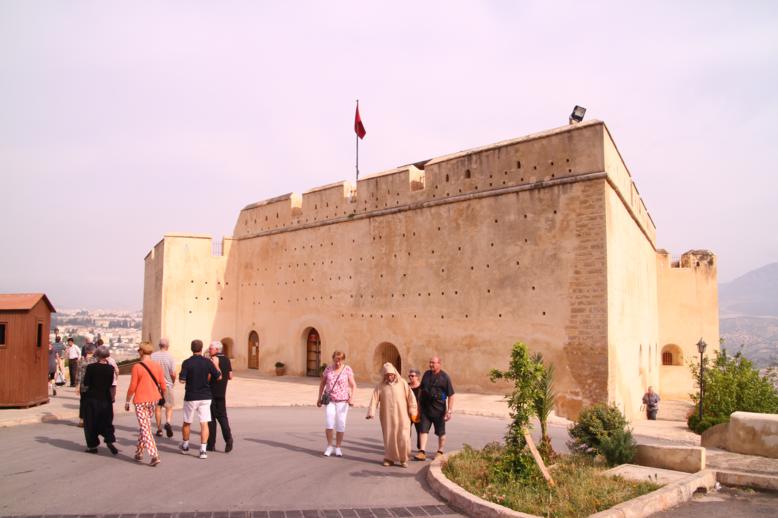 |
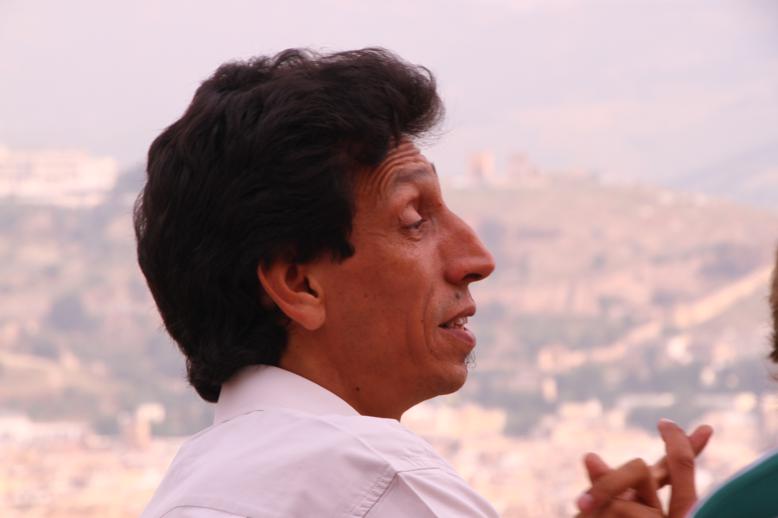 |
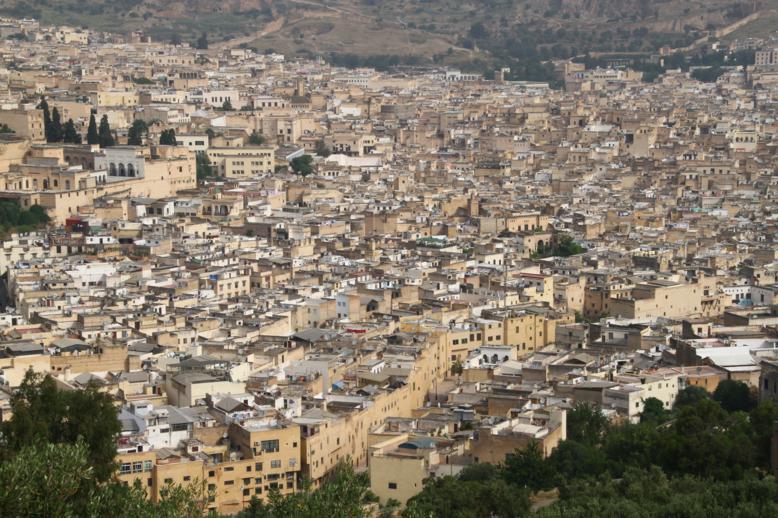 |
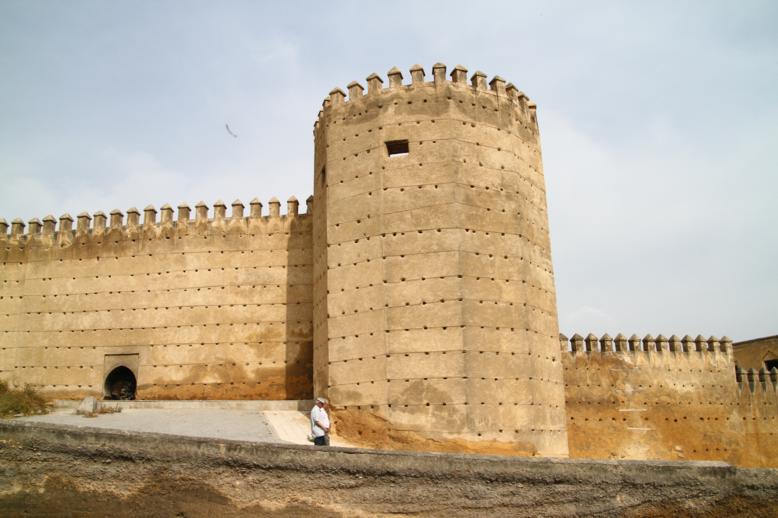 |
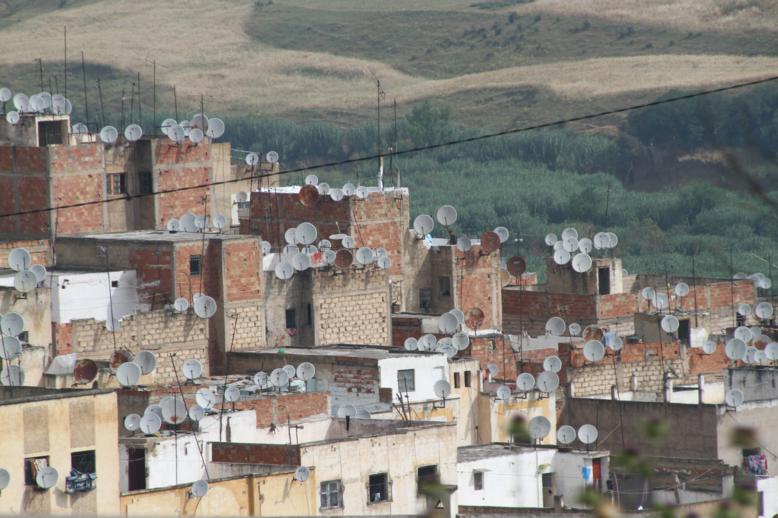 |
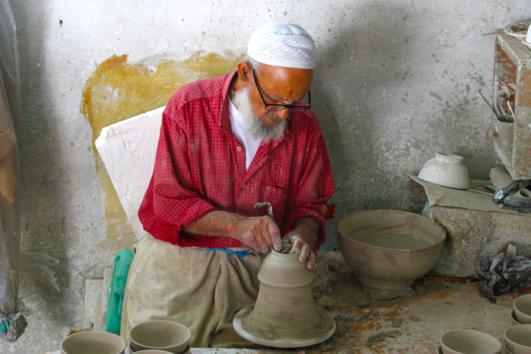 |
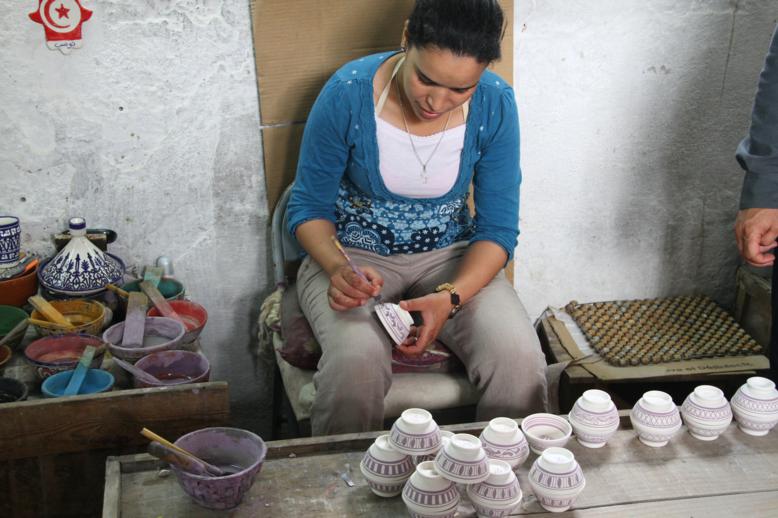 |
 |
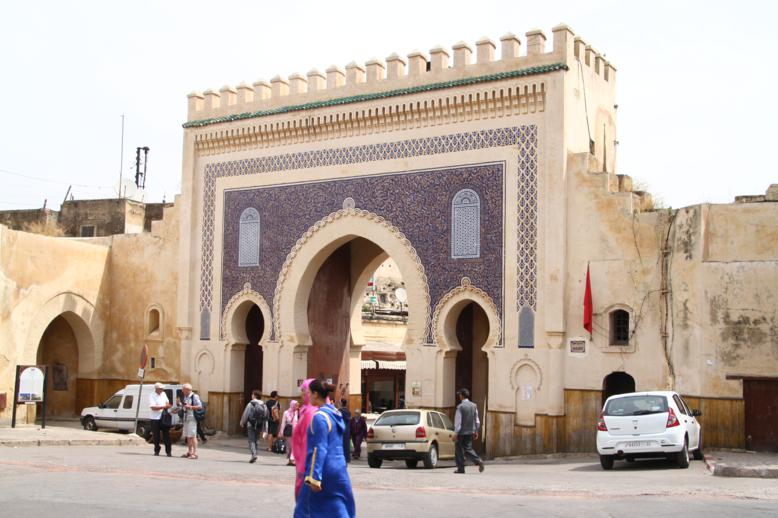 |
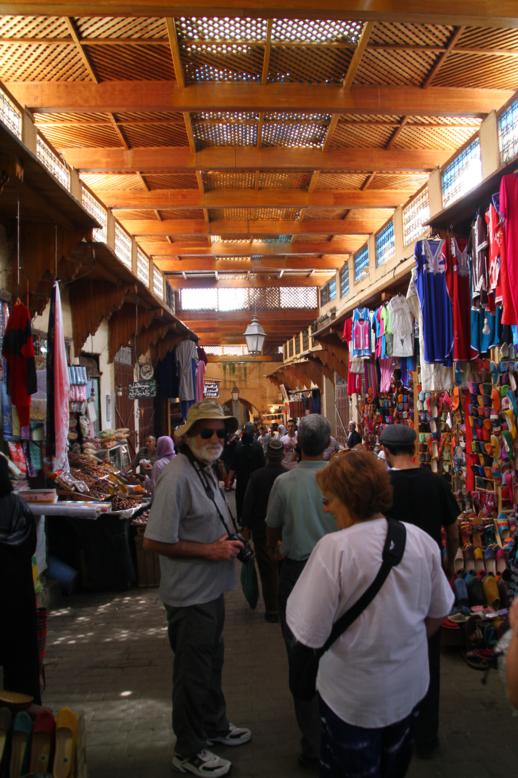 |
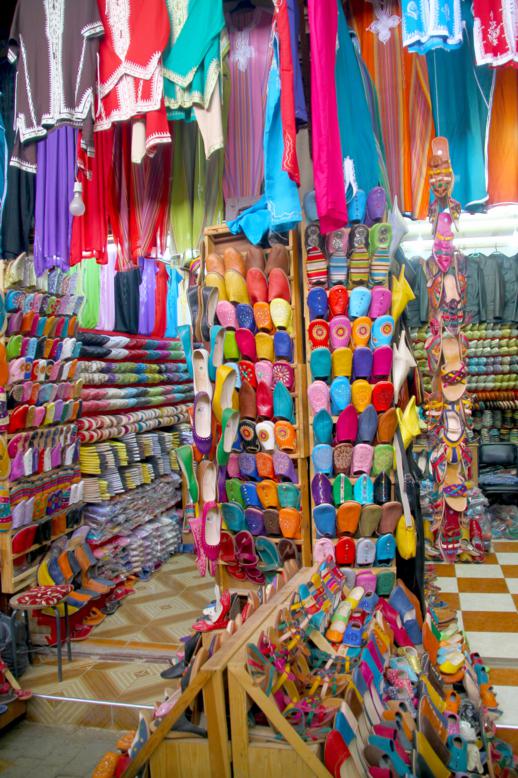 |
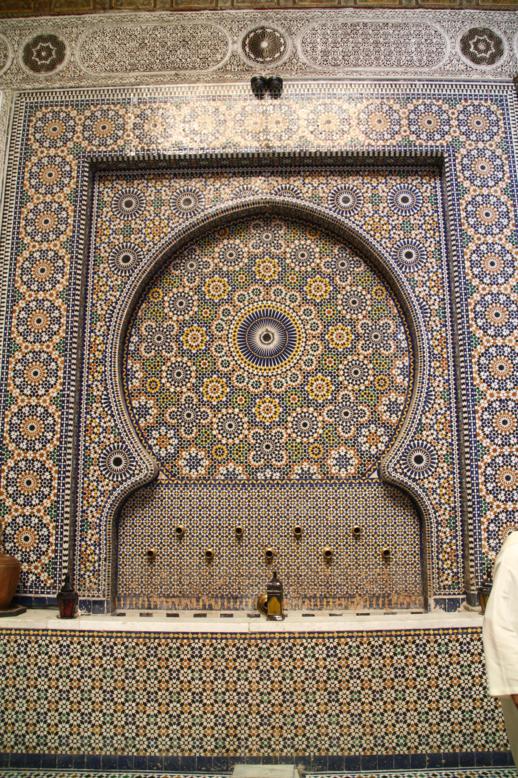 Similar to the Nejjarine Fountain, Fez
Similar to the Nejjarine Fountain, Fez |
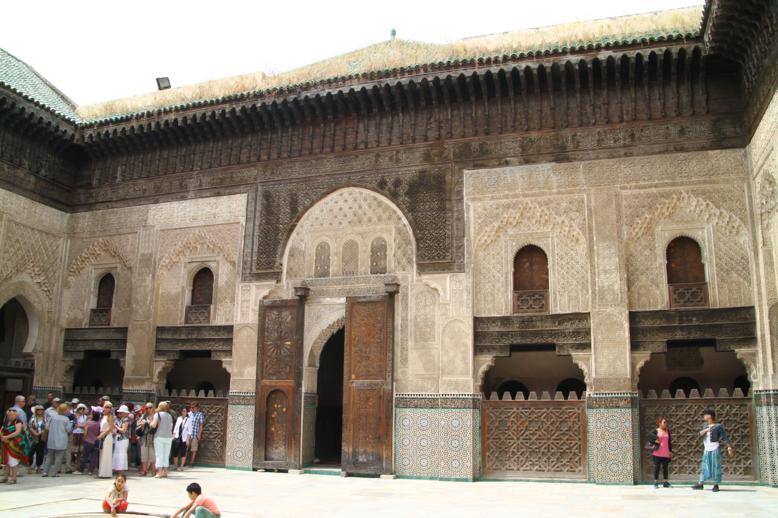 Medersa Attarine, Fez
Medersa Attarine, Fez |
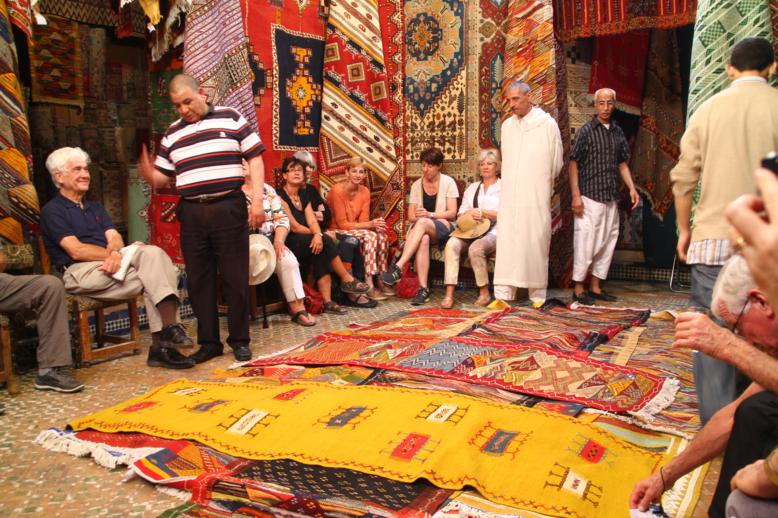 |
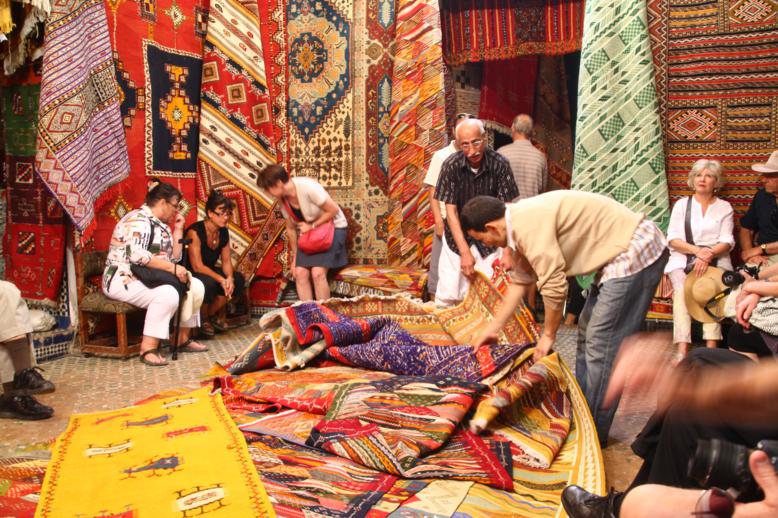 |
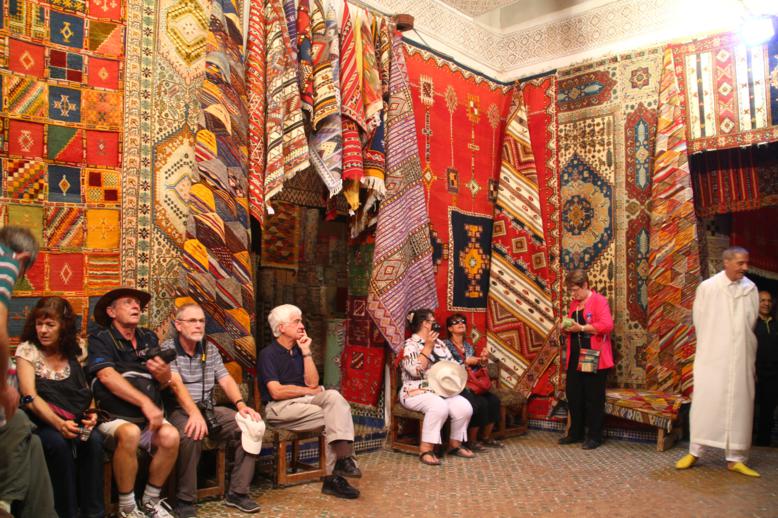 |
 |
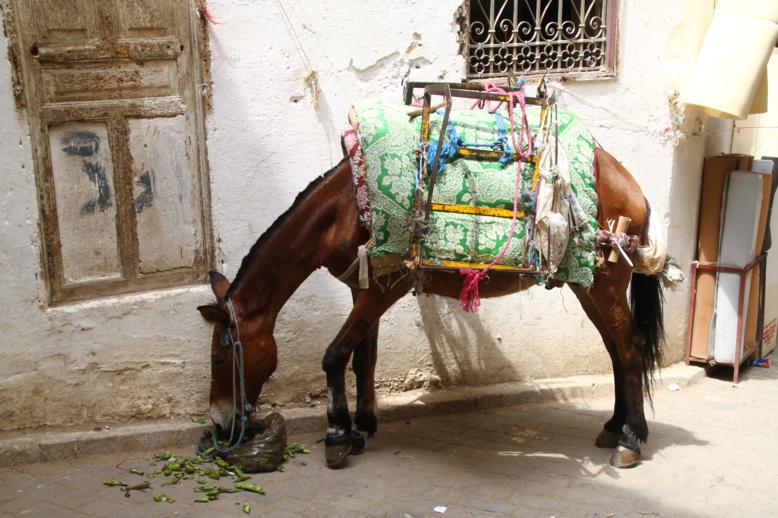 |
After lunch we walked through a maze of narrow streets. Every
few metres we were confronted by a mule or donkey laden with
goods, beggars, men flogging off cheap silverware, hats etc. We
came to a small square in amongst the maze of buildings where
they were making copper goods by beating large sheets of copper
into shape with wooden hammers.
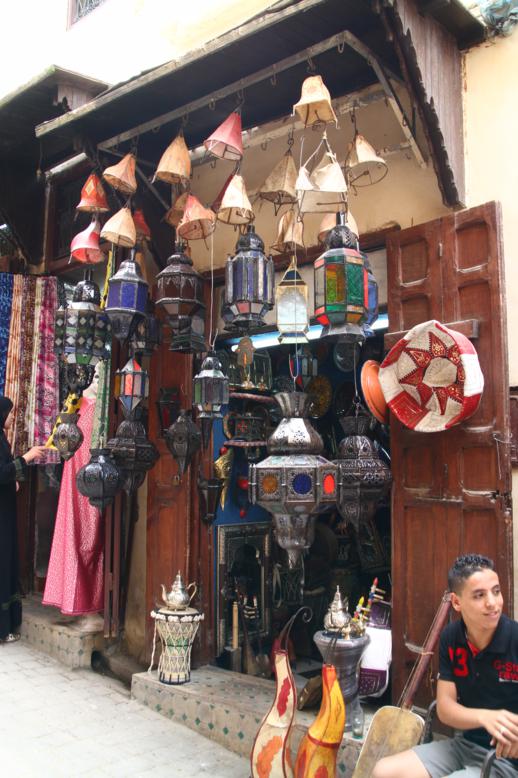 |
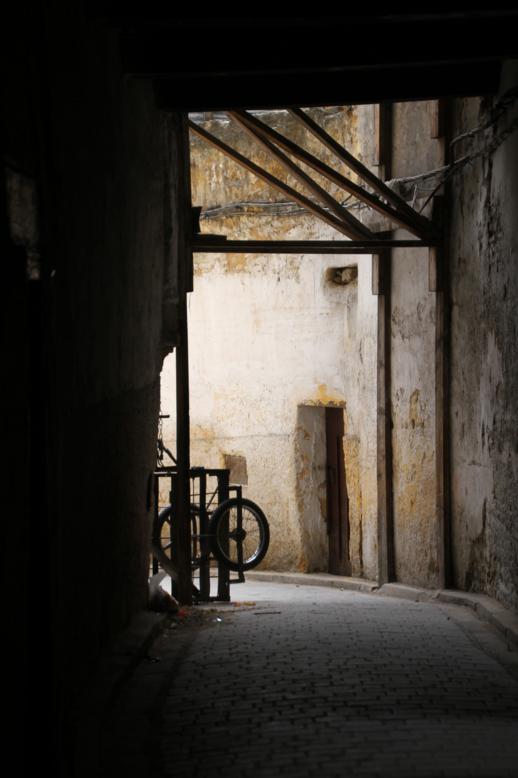 |
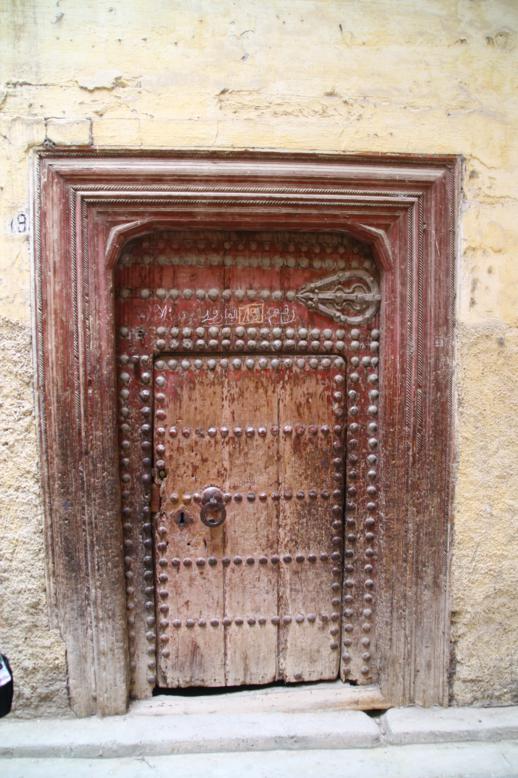 |
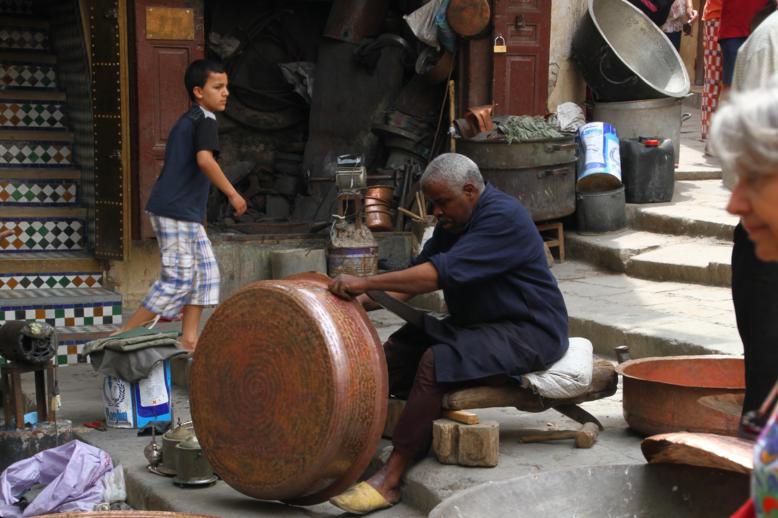 |
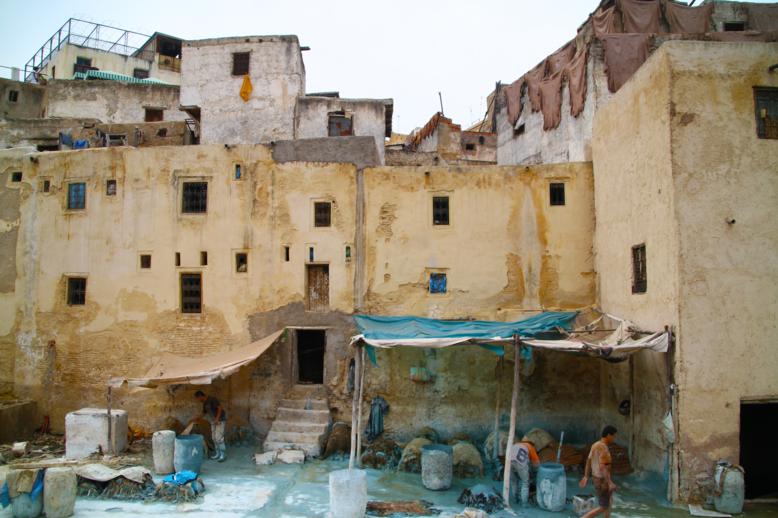 |
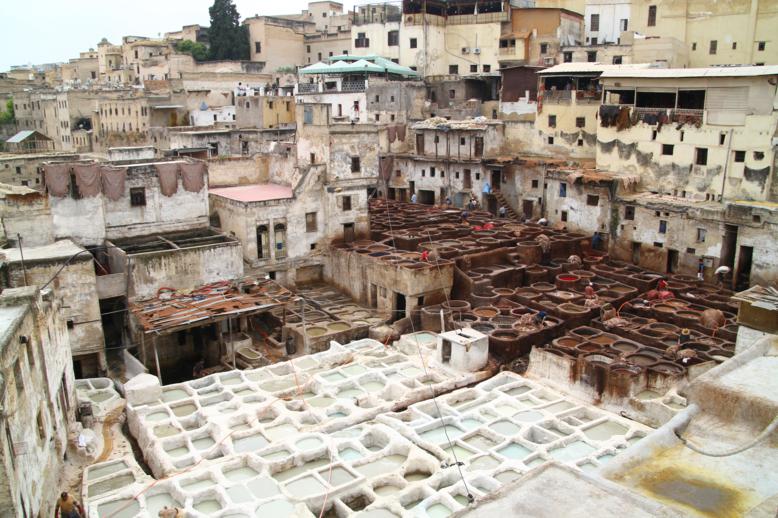 |
 |
 |
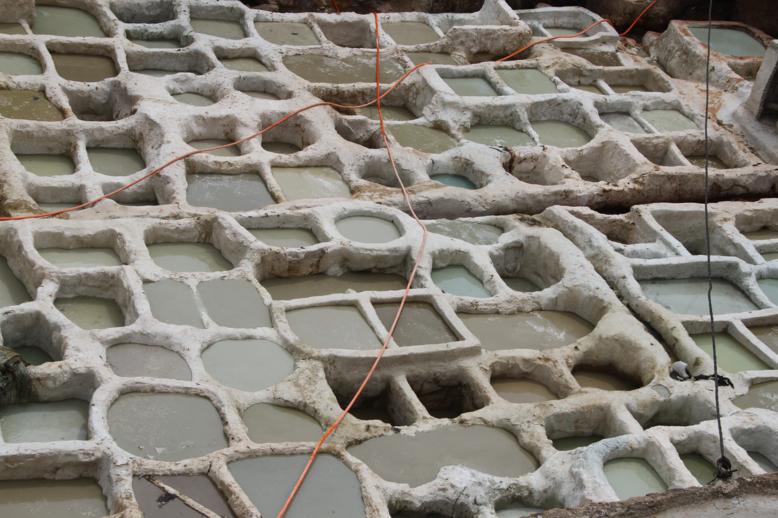 |
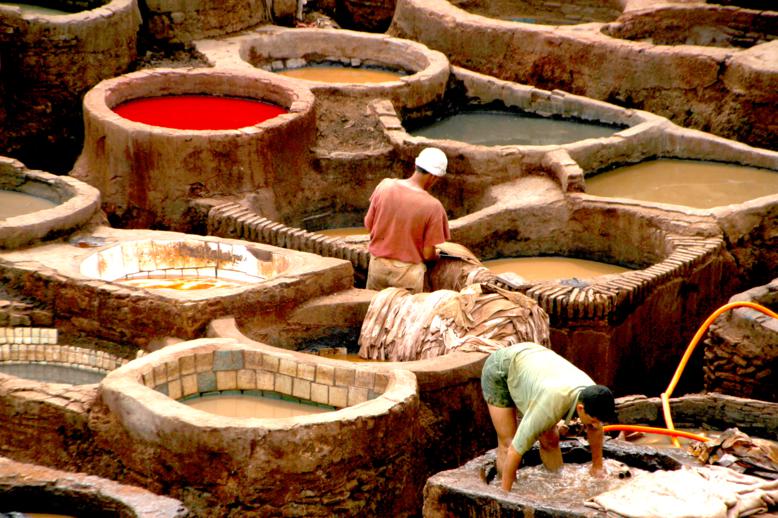 |
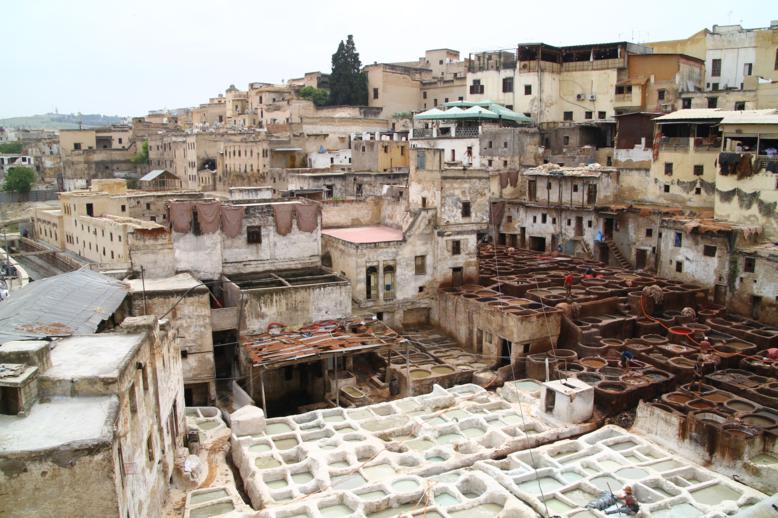 |
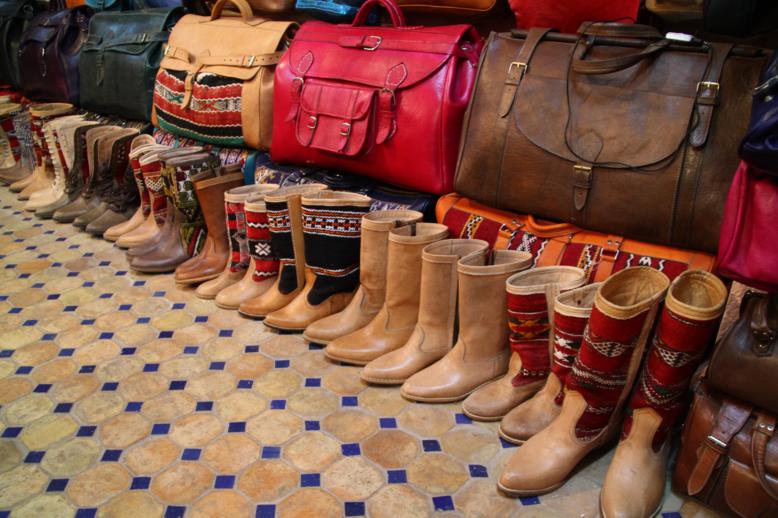 |
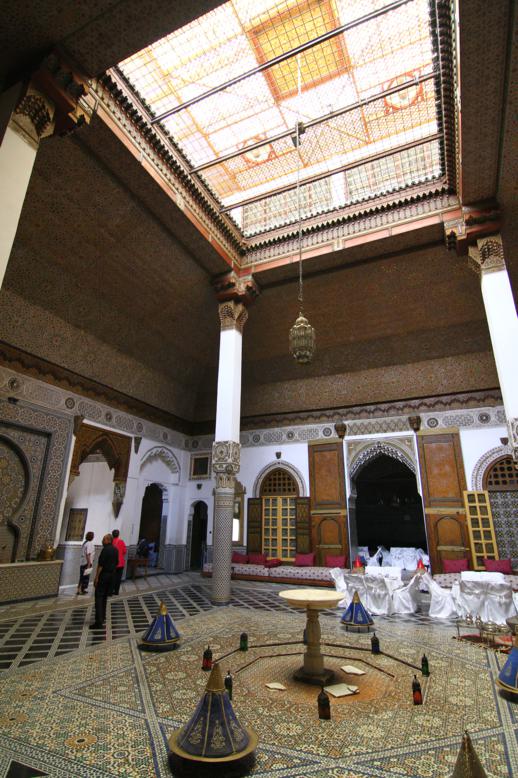 |
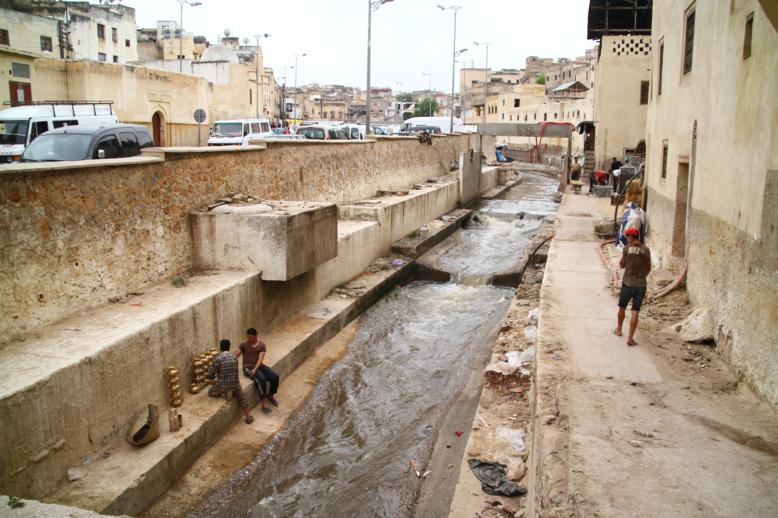 |
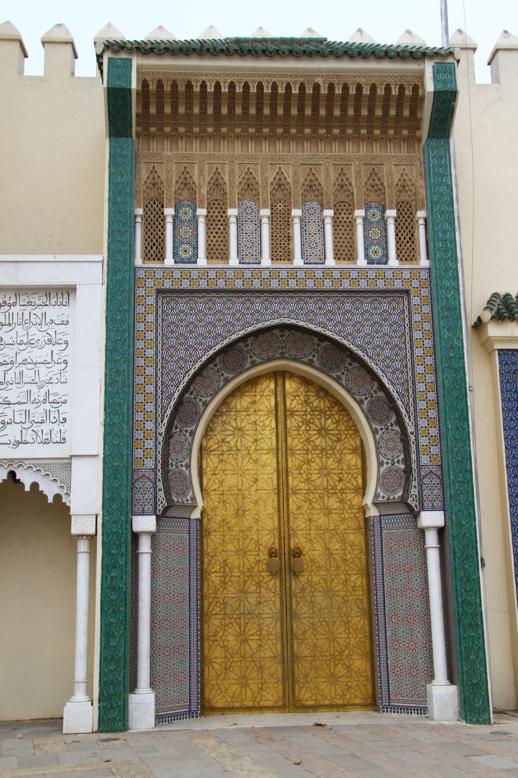 The King's Palace gates, Fez
The King's Palace gates, Fez |
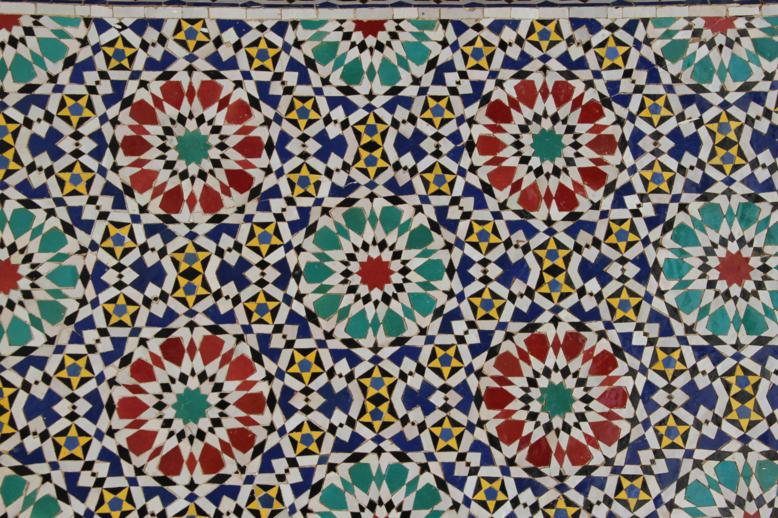 |
We continued down the maze of alley ways until we came to the
tannery and leather works. Here all kinds of rubbish were thrown into the
fast flowing river never to be seen again. The leather dying
vats were quite colourful and the array of leather coats, bags
and wallets etc was quite impressive. Briar bought a coat for
around 180 euros.
We made it back to the bus and took a few photos to the gates of
the Kings Palace. We made it back to the hotel by about 5:30pm
quite tired from the day's experience.
My cold has taken a grip and I now have a persistent cough and I
feel flat. It is always a blessing to get back to the bus and
the airconditioner, even though the outside temperature was in
the low 20s.
|